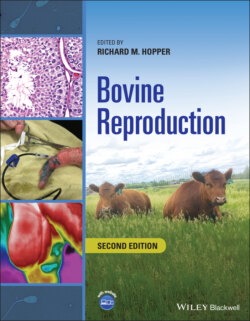Читать книгу Bovine Reproduction - Группа авторов - Страница 169
Examination of the Pelvic Organs
ОглавлениеThe anatomy of the pelvic accessory sex organs is reviewed in Chapter 1. Ultrasonic assessment of the accessory glands of the bull was first described in 1987 by Weber et al. [22] Transrectal ultrasound images are generally sagittal but may also be oblique to the long axis. An ultrasonic evaluation of the tissues is performed after first evacuating fecal material and manually palpating the reproductive tract. The transverse band of prostatic tissue on the dorsal aspect of the cranial extent of the pelvic urethra is a convenient landmark (Figure 10.14). The pelvic urethra is then imaged in a caudal direction (Figure 10.15) until the paired bulbourethral glands are detected (Figure 10.16). Moving cranially, the urethralis is followed until the prostate is encountered again. The paired ampullae are found just cranial to the prostate, on or near the midline (Figure 10.17). The paired vesicular glands are found just lateral to the ampullae (Figure 10.18). An ultrasonic assessment of the bladder should also be done at this time to check for anomalies, cystitis, or calculi.
Figure 10.14 Midline sagittal view of the body of the prostate gland (ovoid tissue above arrow). Dorsal is on top, ventral on the bottom, cranial to the left, and caudal to the right.
Figure 10.15 Sagittal view of the urethralis just caudal to the body of the prostate. The horizontal arrows on the left point to the more hypoechoic urethral muscle above and below the urethra. The more hyperechoic tissue between the vertical arrows is the cavernous tissue immediately surrounding the pelvic urethra. The disseminated prostate is seen as a hyperechoic linear structure on the dorsum of the urethralis (large vertical arrow). Dorsal is on top, ventral on the bottom, cranial to the left, and caudal to the right.
Figure 10.16 Sagittal view of the bulbourethral (Cowper's) gland (between arrows). Dorsal is on top, ventral on the bottom, cranial to the left, and caudal to the right.
Figure 10.17 Sagittal view of the ampulla (between small arrows). Note the distended hypoechoic lumen surrounded by gland tissue. Luminal contents may or may not be seen during examination of normal bulls. The lobar tissue above and to the right of the large arrow is an adjacent seminal vesicle. Dorsal is on top, ventral on the bottom, cranial to the left, and caudal to the right.
Figure 10.18 Oblique view of the seminal vesicle (horizontal tissue between arrows). Note the lobar architecture. A short segment of the hypoechoic central duct is seen in the center of the gland between the two arrows.
Pathology of the bulbourethral glands and prostate is uncommon. Aplasia [6] and sperm accumulation [23] have been reported in the ampullae. Inflammation of the vesicular glands is relatively common in bulls and should be suspected whenever an asymmetry in size or echotexture is encountered. Inflamed glands are larger and often have a mixed echogenicity, while abscessed glands show a loss of lobar architecture and often have a globoid area of variable echogenicity [24]. A bacterial infection is most commonly incriminated as the cause of seminal vesiculitis, but sterile inflammation resulting from urine or sperm leaking into the glands is also a potential etiology. Figure 10.19 is an ultrasonogram from a two‐year‐old beef bull with segmental aplasia of the right vesicular gland. Note the cystic dilation of the occluded central duct. The gland was much larger compared with the gland on the left. This bull also had aplasia of the right epididymal tail and a grossly distended hypoechoic right rete testis.
Figure 10.19 Oblique view of the seminal vesicle (above vertical arrows). This bull had a segmental aplasia of the seminal vesicle on this side resulting in the cystic distension of the central duct (horizontal arrow).
